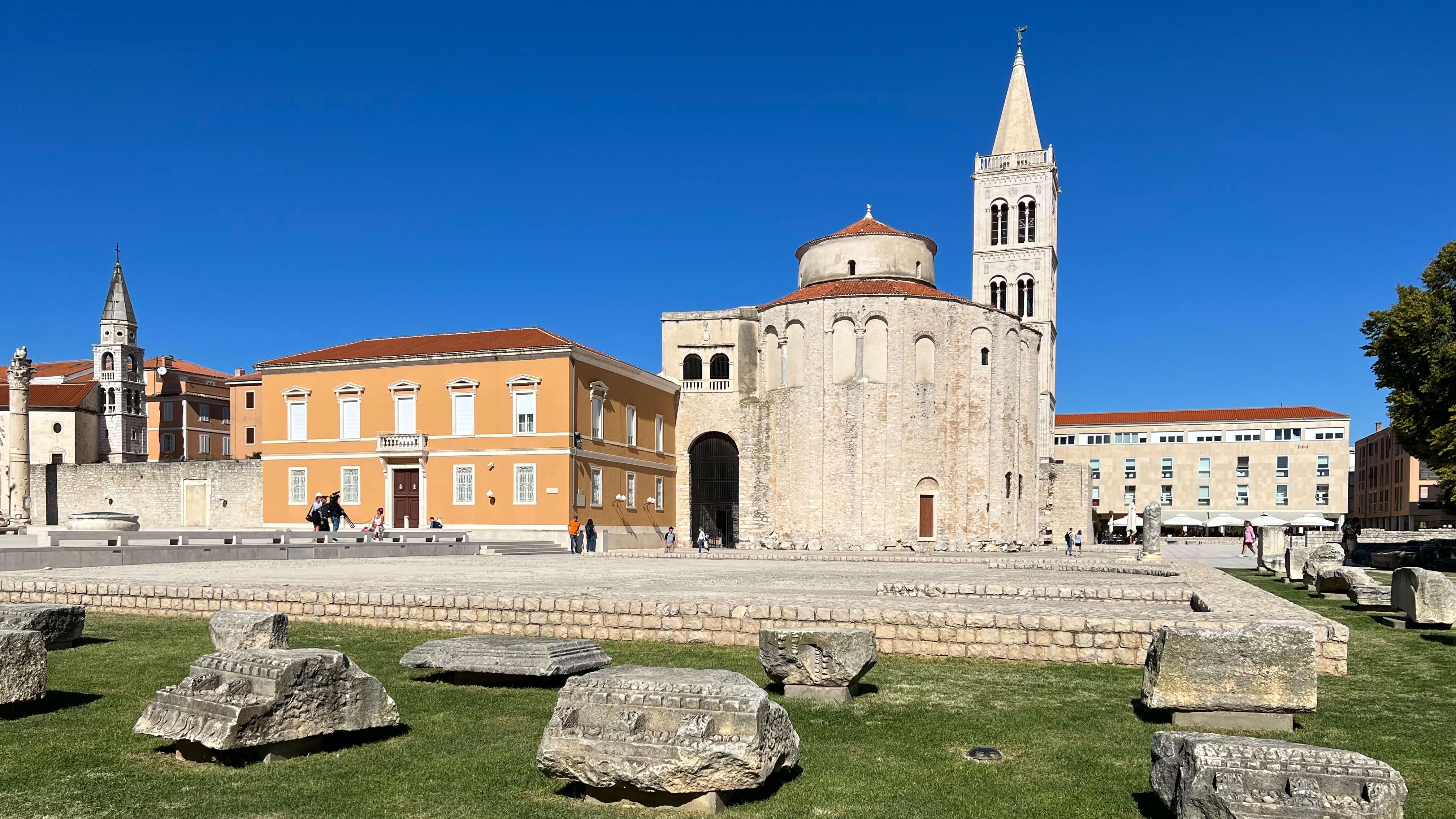
Table of Contents
Were Zadar’s city planners chasing the “Bilbao Effect” when they hired Nikola Bašić to build two contemporary art installations near the historical old town? Most likely. But there’s more to these works of art than meets the eye.
The Croatian-born architect completed The Sea Organ and The Monument to the Sun nearly 20 years ago. Today, it’s impossible not to mention them when discussing 3,000-year-old Zadar.
And yet, Zadar is still tourist-light compared to Split and Dubrovnik. As a result, it’s retained a local vibe, making it a delightful place to visit whether you’re interested in history, culture, art, or simply relaxing by the sea.
Date of Visit: September 23, 2022
The Sea Organ
The Sea Organ plays an other-worldly symphony as we walk along the water’s edge. The sound comes from waves entering and exiting 35 organ pipes of various widths and lengths buried under the busy esplanade. The organ plays day and night, its mournful overtures escaping through slots in the white marble steps.
A powerboat glides past. Its wake adds deeper chords to the discordant harmony and blends with the voices and laughter of young families, friends, and lovers enjoying the warm Croatian sun.
The Adriatic Sea has played this never-ending symphony since the completion of the sound art installation by Bašić in 2005. This unusual organ has a range of seven chords and five tones.
It is one of two modern art attractions in Dalmatia’s historic port city, Zadar. I must admit both struck me initially as out-of-place in an ancient town.
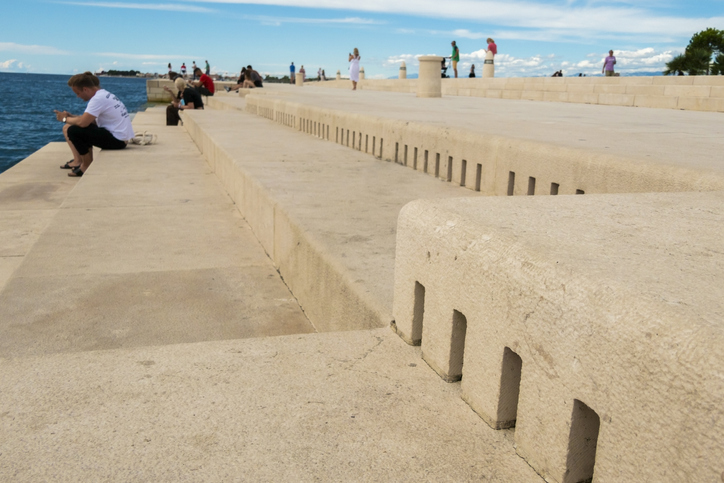
The Monument To The Sun
The Monument to the Sun, also called The Greeting to the Sun, is a second art installation near The Sea Organ. It is a circular installation of solar panels that lights up at sunset, creating a dazzling display of colors and patterns.
Smaller inlaid installations nearby represent planets. The steel frame outlining the circular glass plates lists the names of priests from Zadar’s churches.
The architect Bašić, who went to school in Zadar, designed it, too.
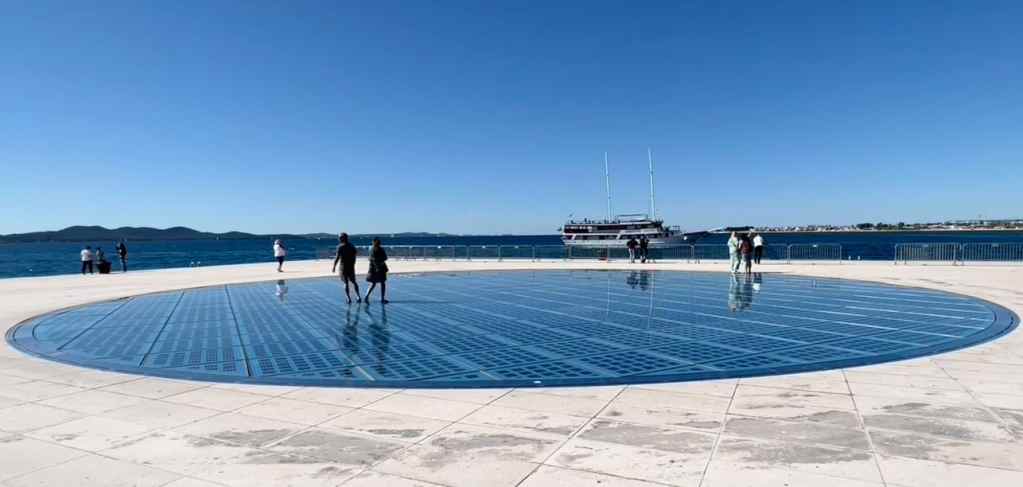
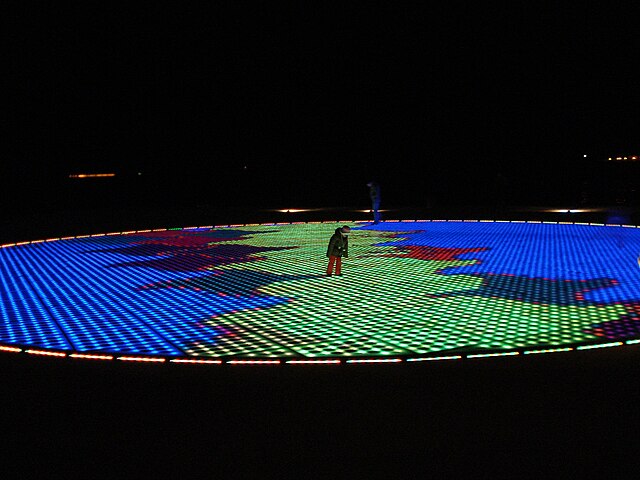
A Deeper Message
I now realize that these two installations are more than just tourist attractions. They are a powerful connection between Zadar’s past and present. In addition, they are a celebration of the natural world and a reminder of the power of art to connect the past, present, and future.
The Sea Organ is an ode to Zadar’s long and rich maritime history. The city has been a port of trade and commerce for centuries, and the sea has always played a vital role.
The Monument to the Sun symbolizes Zadar’s resilience and hope for the future after centuries of conflict and destruction. It pays homage to Croatia’s deep religious roots and recognizes the Catholic church’s historical support for astronomy.
Both speak to Zadar’s spirit of renewal and its commitment to innovation.
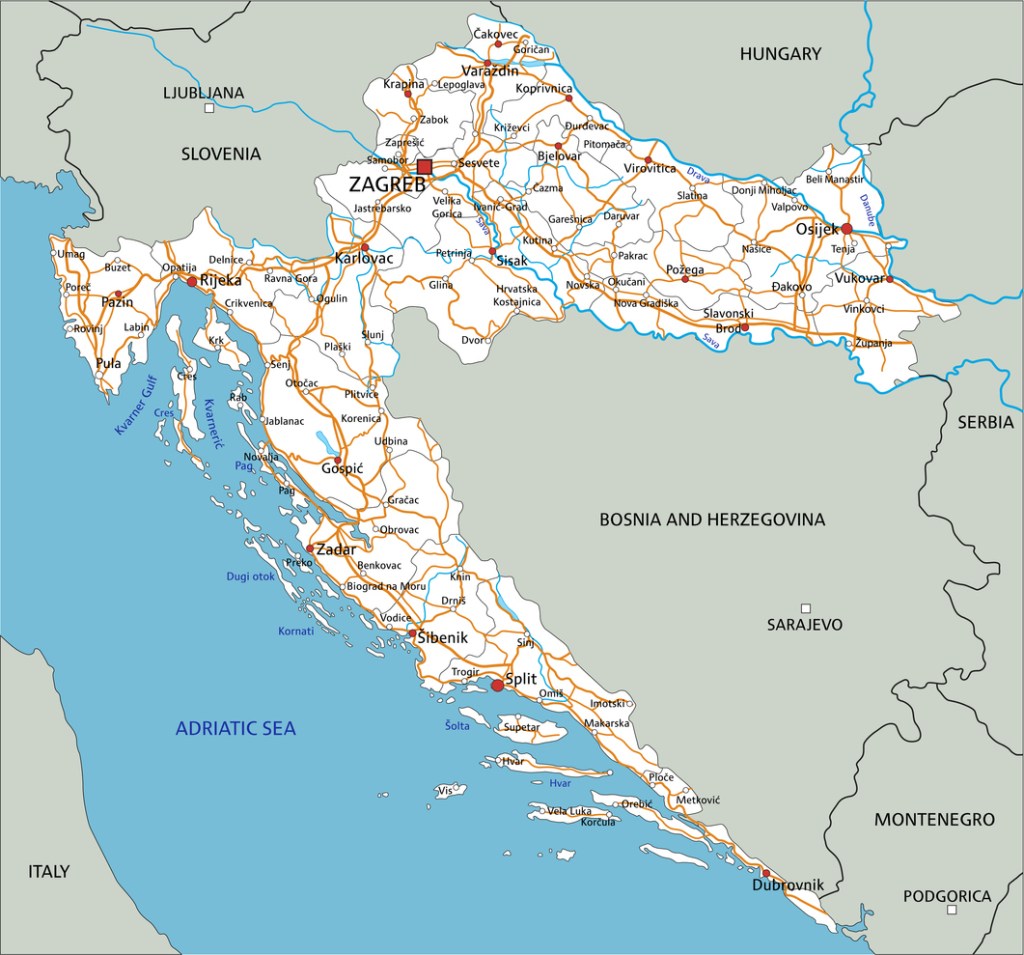
Zadar Celebrates the Past and Present
Until Chris and I arrived in Zadar, most of what we’d seen in Croatia’s towns and cities were Roman ruins mixed in with Habsburg- and Socialist-era buildings. As we made our southwesterly journey, we saw our first Croatian fishing and cruise ship harbors (Rovinj and Pula). It was as if time stood still in Croatia.
But the 3,000-year-old city of Zadar is known today as much for its pretty esplanade, Roman Forum, and not-so-pretty post-World War II housing (outside of the historic section) as for its two contemporary art installations.
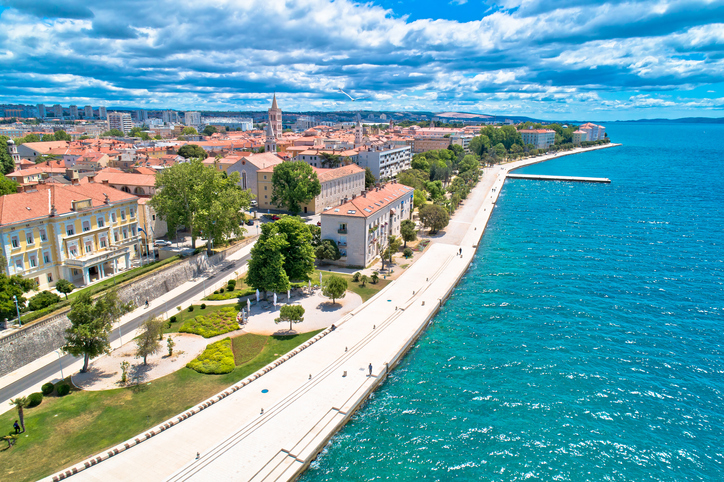
The Largest Roman Forum in Croatia
After puzzling over the significance of The Sea Organ and The Monument to the Sun, we walked south along the peninsula toward town, where we came to the ruins of the Roman Forum dating from the 1st century BC to the 3rd century AD.
It’s an unusual open archeological site where visitors can walk through the remains of an ancient temple, market and civic center. An Archeological Museum, housed in an unattractive Brutalist-style building, overlooks the bits and pieces of stone and rubble that is all that remains of the most significant Roman Forum discovered in Croatia.
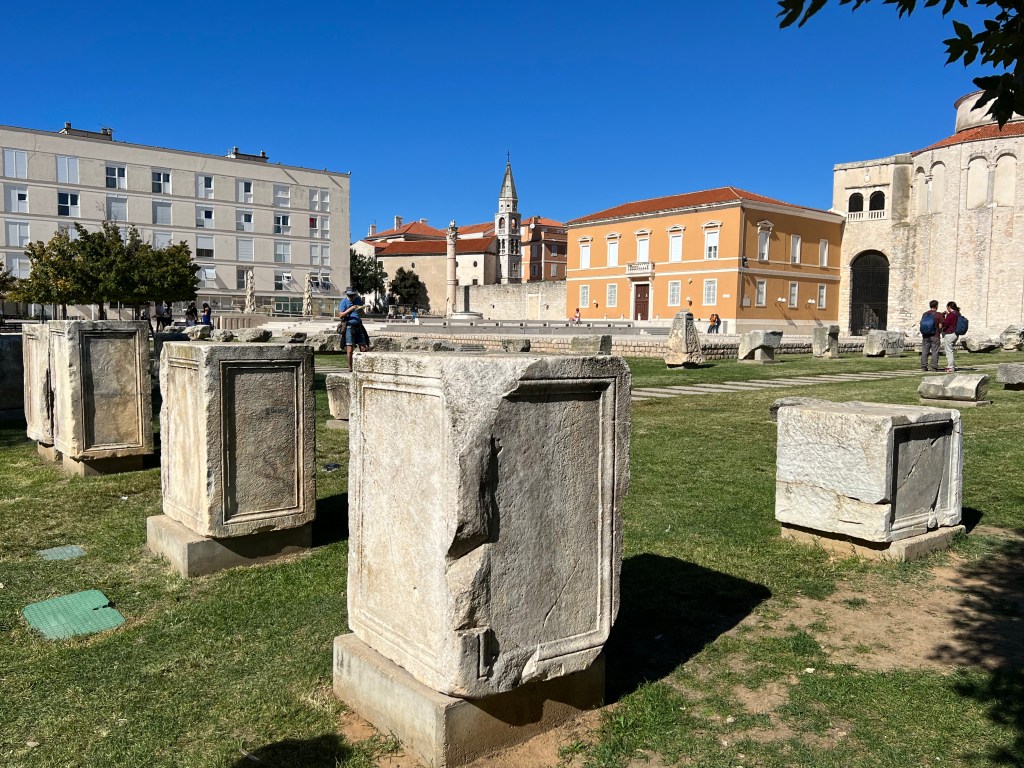
Though it gets only a passing mention in tourist guidebooks, Zadar’s Forum was one of ancient Rome’s most important contributions to the eastern Adriatic. Many of these archeological treasures lay buried and were buried until the 1930s and later.
The Pillar of Shame
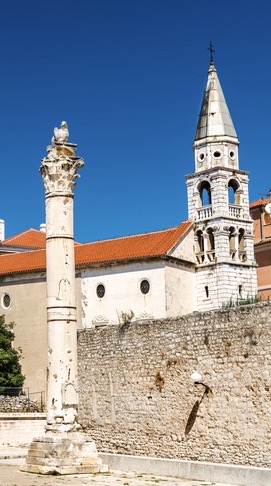
There is little left of the once bustling market area. A Corinthian column that decorated a former temple worshiping the three Capitoline Triad gods of Jupiter, Juno, and Minerva stands prominently at the far end of a grassy lawn. Sections of columns and pieces of the temple lay scattered about the grounds.
The first Roman Emperor, Augustus, commissioned the construction of this pillar between the 1st and 3rd centuries BC.
During the Middle Ages, long after the Romans, people were publicly humiliated for misdeeds by being chained to this pillar. A piece of the original chain is still attached to the column.
Church of St.Donatus
The distinctive round Church of St. Donatus dominates the backdrop. The bell tower behind it belongs to the Church of Anastasia. Builders completed the ground and first floors of the tower in 1452. In 1894, a new generation of builders completed the upper part.
If you are up to climbing 183 steps, you can purchase a ticket to see Zadar from a high.
In the 9th century, builders constructed St. Donatus Church from the remains of the Forum.
Hundreds of years ago, the Catholic Church deconsecrated St. Donatus Church. Since then, it has stored military supplies and was the archeological museum until the 1950s. For 30-plus years, it has hosted the international festival of medieval and Renaissance music.
Tourists in shorts and sun dresses walk among the relics as if examining sculptures at a modern art show. It’s surprising to see if you’ve visited places like Stonehenge in England, where the public is not allowed within 15 yards of the massive stones. Even concerts are held among the relics.
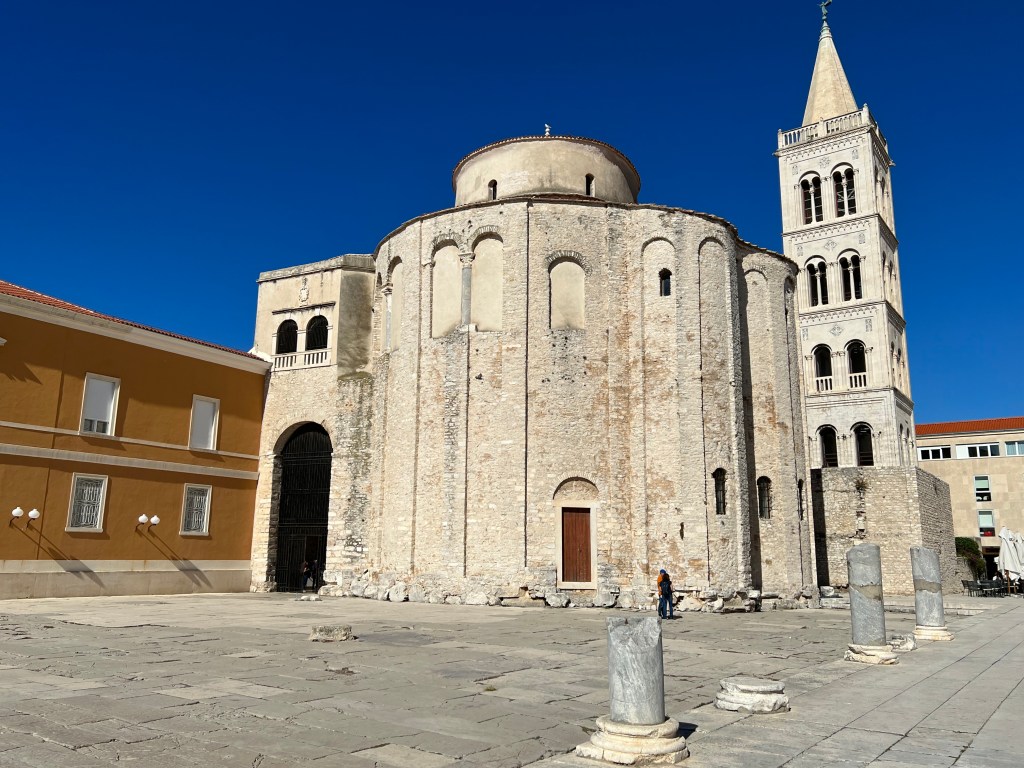
A Devastating Earthquake and War
A terrifying force of nature and several wars (World War II and Croatia’s Homeland War of Independence caused much devastation to this 3,000-year-old town.
It took ancient artisans several hundred years to build the marketplace, but only minutes for an earthquake in 6 BC to tear it down. During World War II, Allied bombs targeted the city to oust the Ustaše (Croatian fascists). Again, there was much devastation. More recently, in 1991, Zadar found itself on the frontline during the Homeland War for independence from Yugoslavia.
Many Sights To See
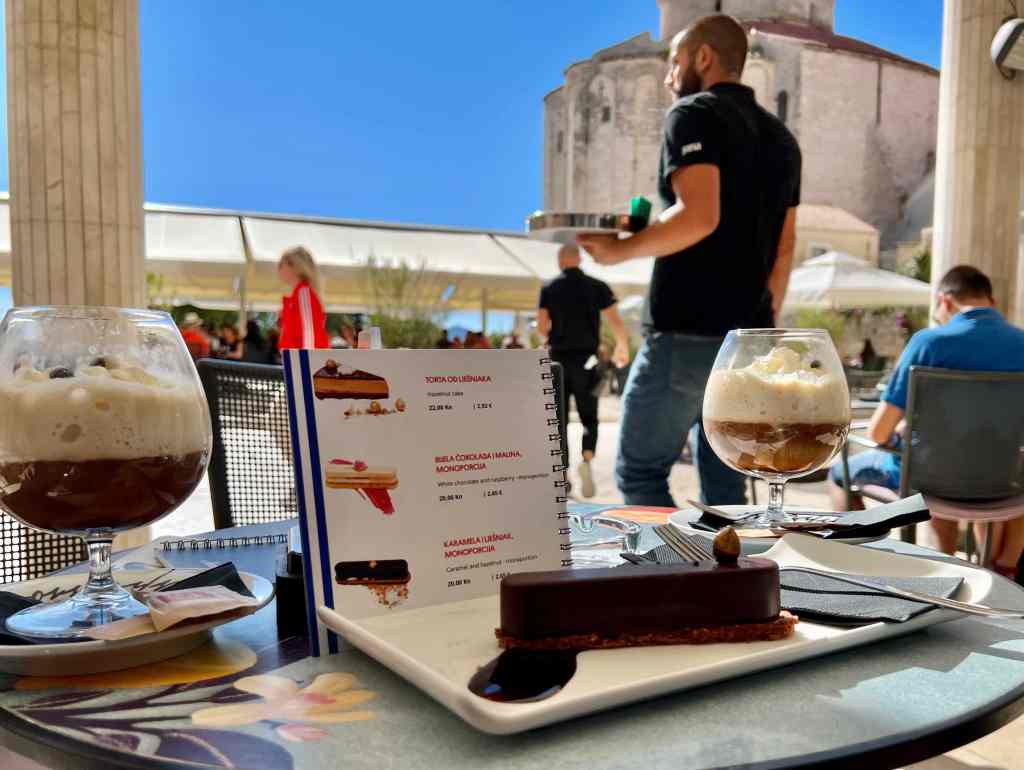
We spent only a few hours in Zadar on our day journey from Plitvice Lakes National Park to Split. Still, it was enough time to grab a bite at one of the many outdoor cafes that line the street behind the Roman Forum and St. Donatus Church.
Fueled by a delicious caramel and chocolate pastry and two Irish coffees, we strolled the polished limestone streets and took in some of the noteworthy sights in the historic district.
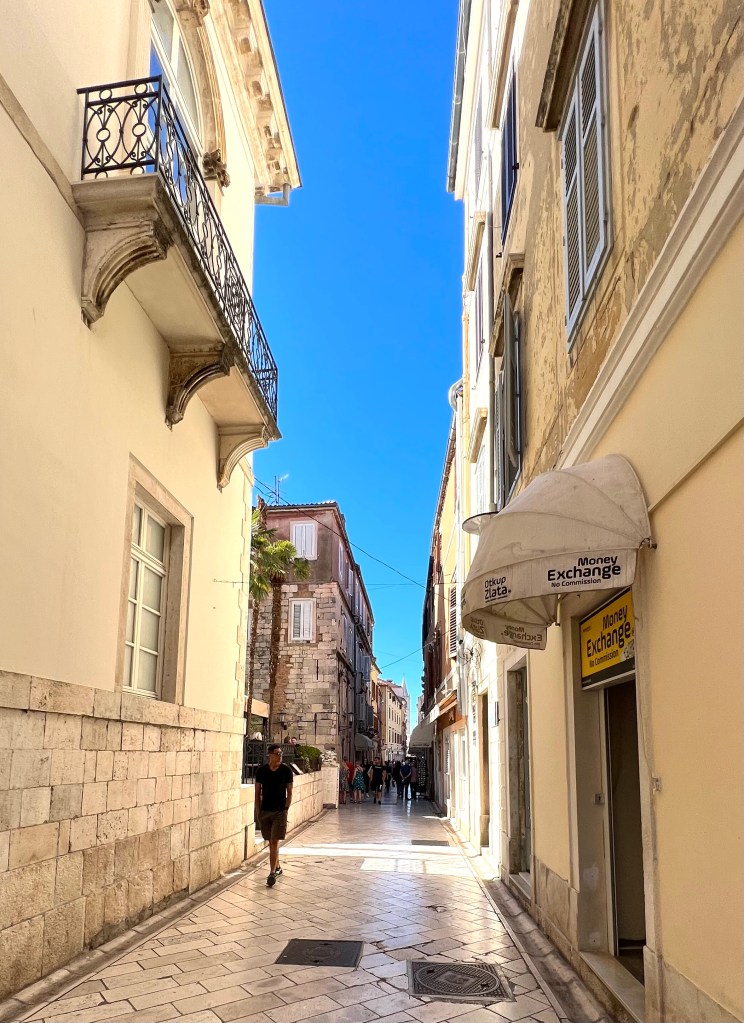
The People's Square
We walked the narrow pedestrian Broad Street (Kalelarga) that leads to The People’s Square, a local hangout notable for its 16th-century Guardhouse, the City Loggia, and the Romanesque Ghirardini Palace with a balcony dating back to 1480.
The City Loggia is a former courthouse first mentioned in 1282. The current building dates from 1565. It hosts photo and contemporary art exhibits now.
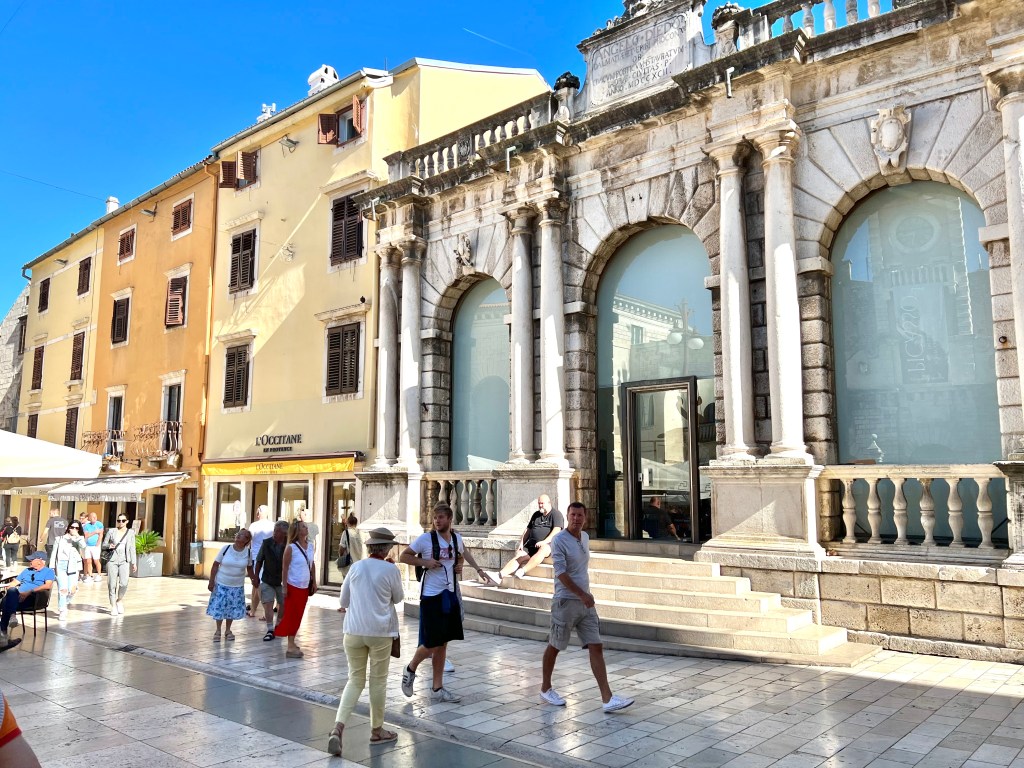
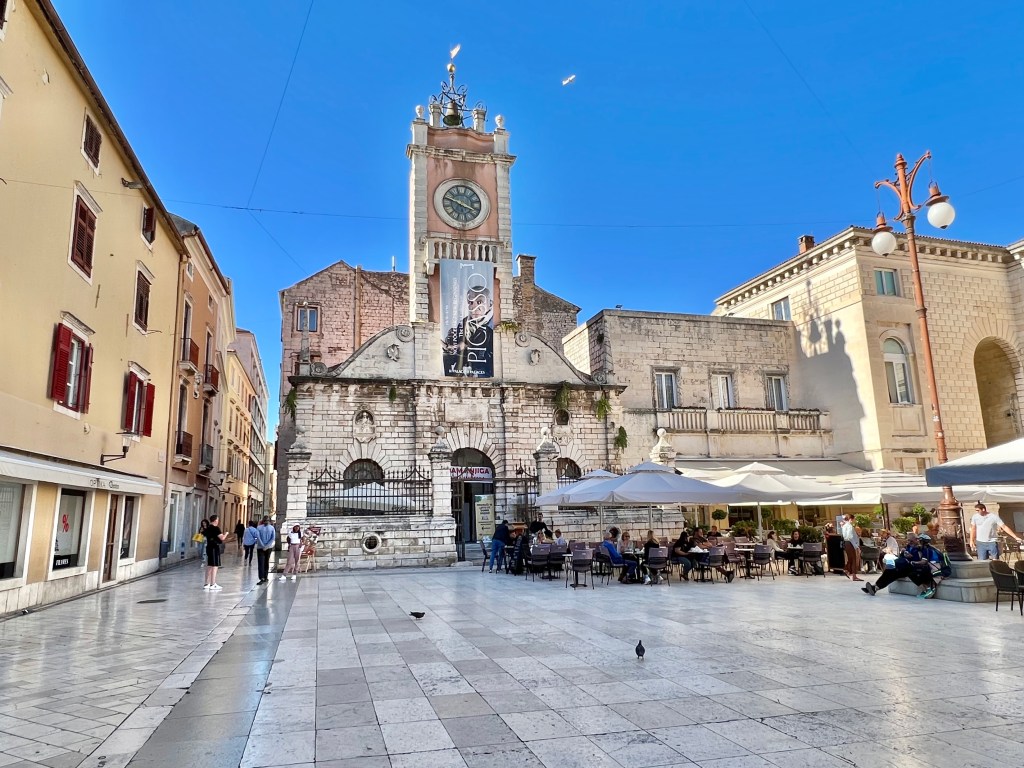
Petar Zoranić Square
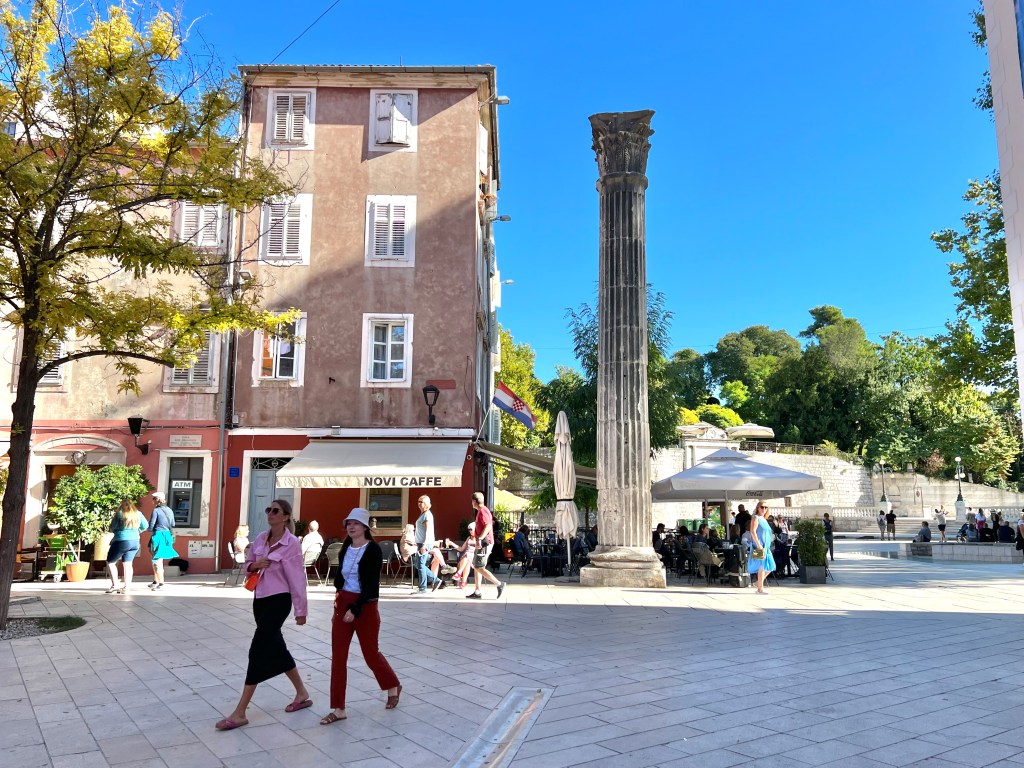
We wandered to Petar Zoranić Square, a charming plaza where Roman history intersects with Austrian-style buildings and cafes. The square takes its name from a novelist and poet from Zadar who wrote the first Croatian novel in the Renaissance era.
The first thing you will notice is a tall, fluted Roman column. It didn’t always stand there. It was created in the Austrian era in 1729 from the fragments of two Roman columns standing alongside the Pillar of Shame in the Capitolium’s temple in the old Forum.
Don’t miss the three glass windows set flush with the stone pavers as you walk through the plaza. Here, you can view the remnants of a medieval gateway, the octagonal base of a tower that once stood next to the Roman gateway, and the base of a Roman arch.
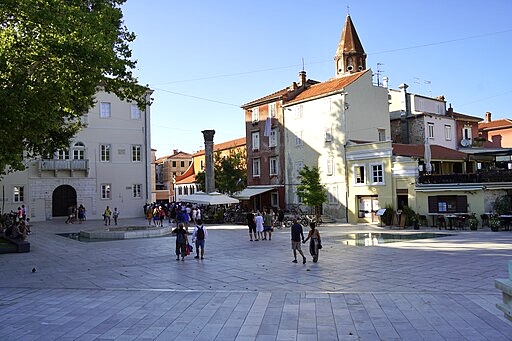
Five Wells Square
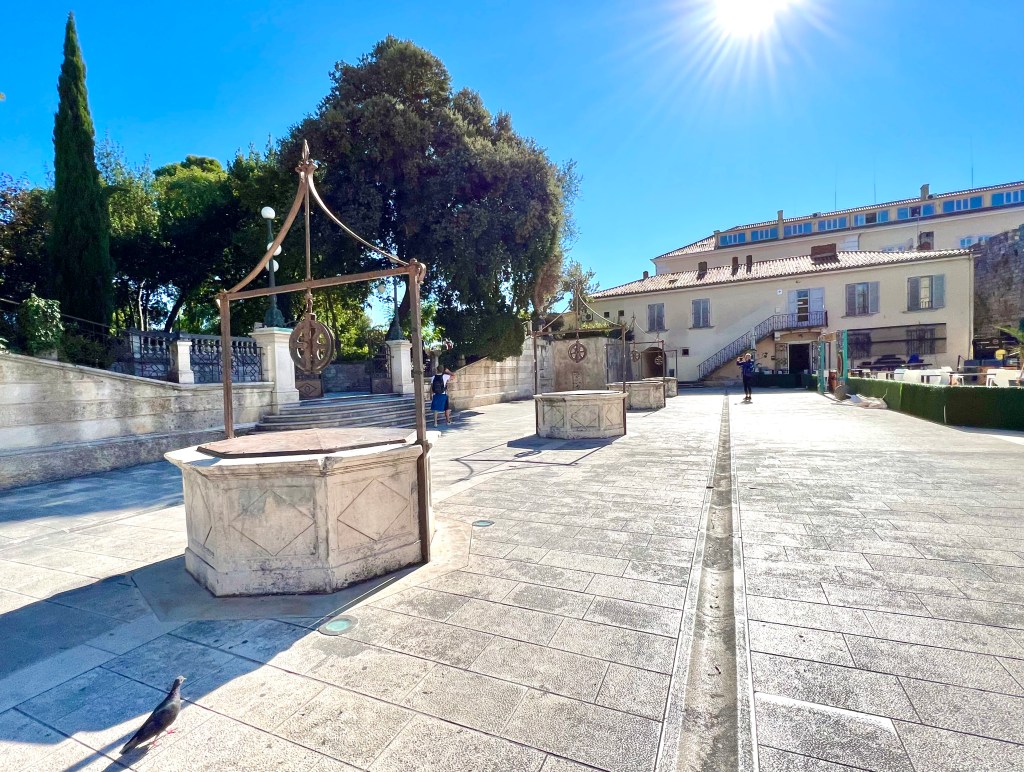
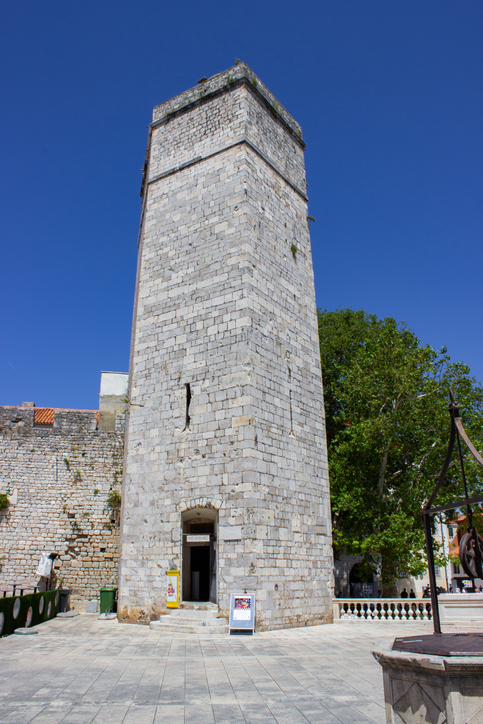
In the adjoining Five Wells Square stands a crenelated medieval stone wall and guard tower, built in the 12th and 13th centuries and fortified in the 16th century against the Ottomans.
It’s called the “Walls of Zadar Uprisings,” referencing the 11 times Zadar’s citizens rebelled against the governing Venetian Republic.
The Captain’s Tower picked up its nickname years later when a Venetian Captain took up residence nearby.
Five ornamental wells straddle a cistern storing water from a long-ago moat. Built during a Turkish siege, they ensured the townspeople had access to fresh water.
Park of Queen Jelena Madijevka
Behind Grimani Bastion and a medieval stone wall lies Dalmatia’s first public park named after the medieval Queen Jelena Madijevka.
The park offers a stunning birds-eye view of The Land Gate (built by the Venetians) and tranquil footpaths through the gardens.
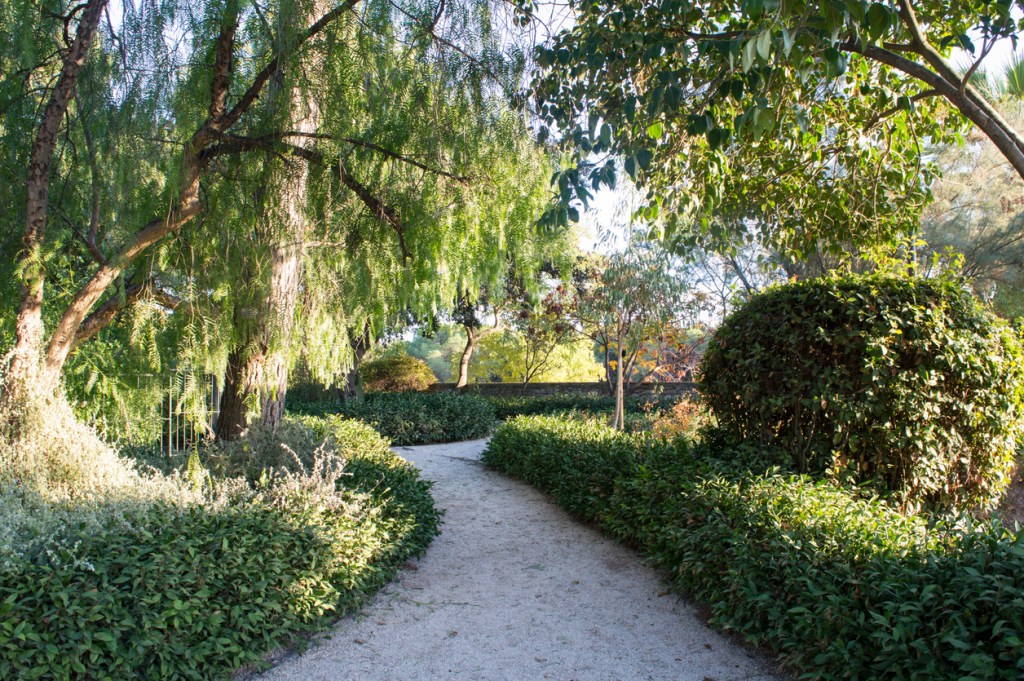
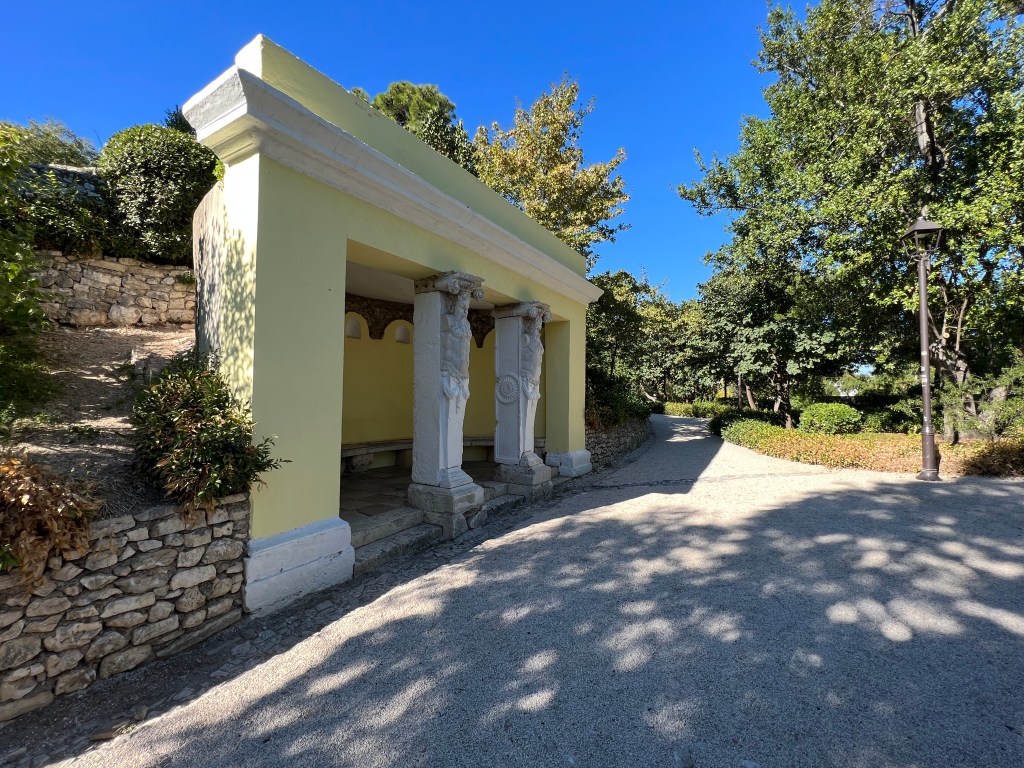
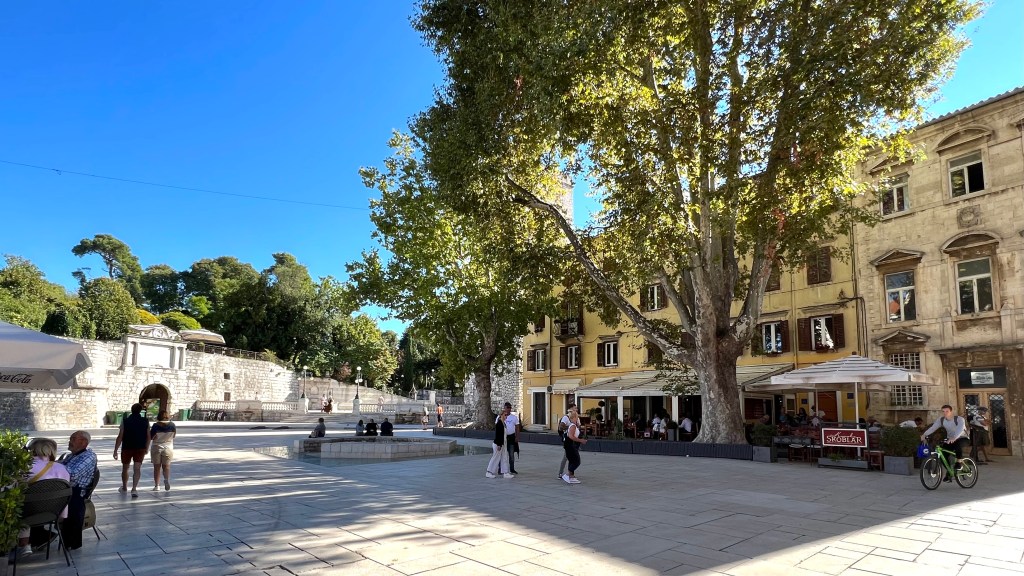
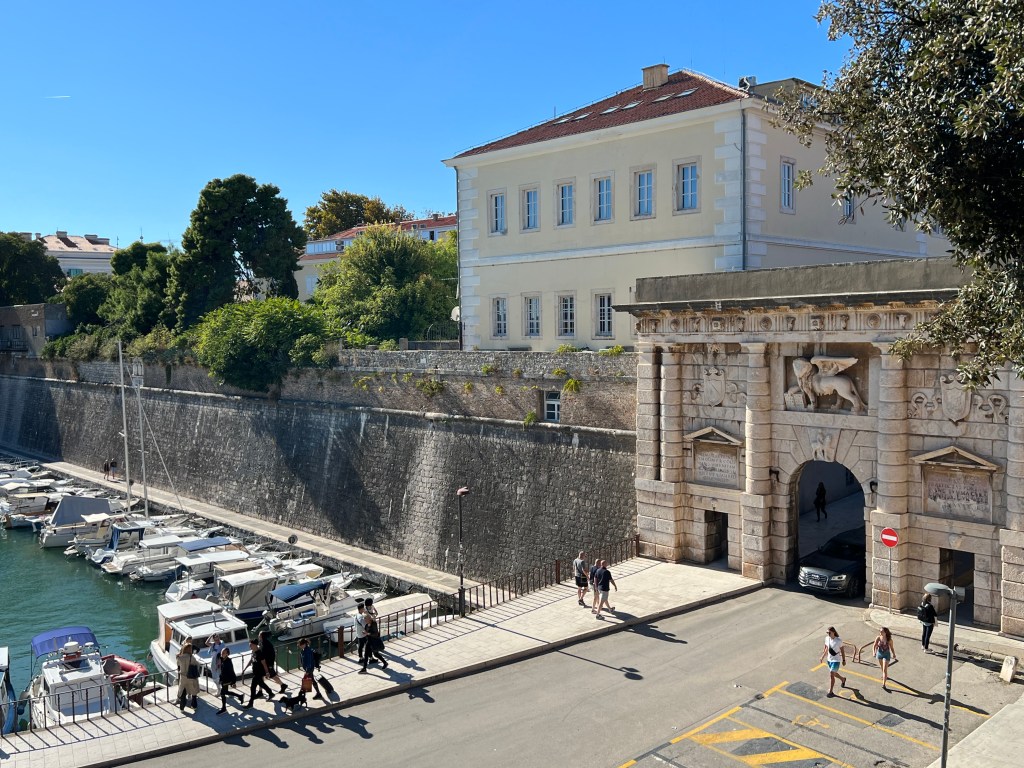
An Overlooked Seaside City
Most tourists make a beeline to Split and Dubrovnik, making Zadar a contender for one of Croatia’s most overlooked seaside cities in the Dalmatia region. But that also means it is refreshingly free of suffocating crowds.
Zadar is a 2 1/2 hour drive from Plitvice Lakes National Park and 2 hours from Split. It was the perfect stop after we hiked Plitvice Lakes that morning and headed to Split.
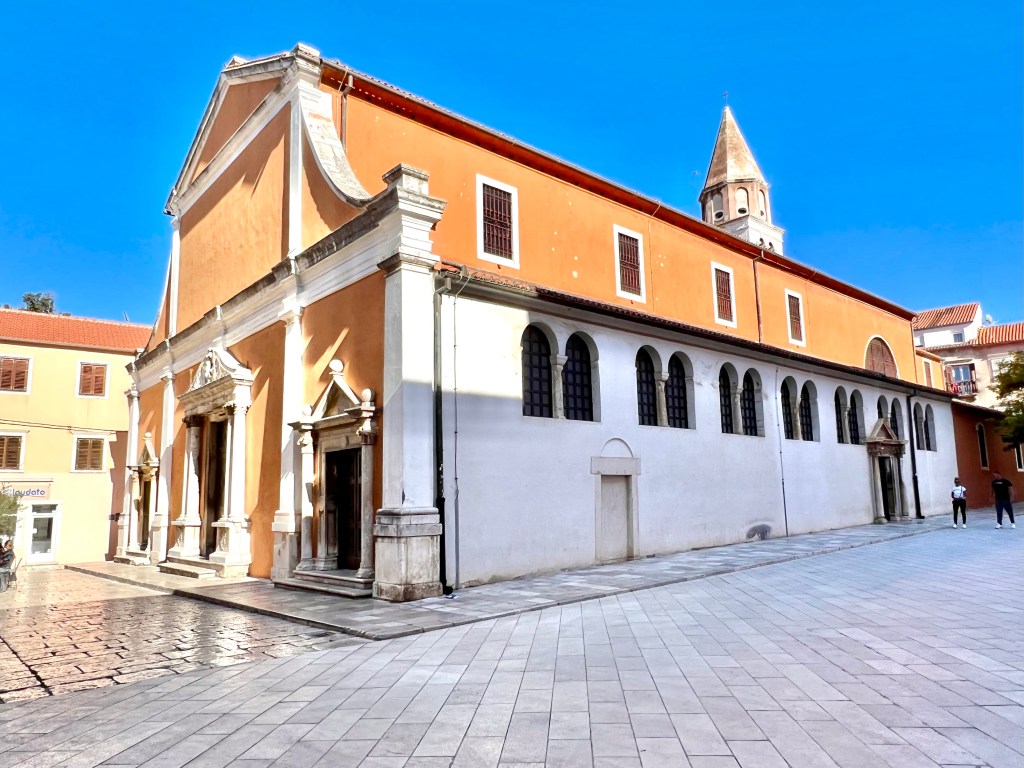
What to Do In Zadar
Of course, if you decide to stay longer, there is much more to see and do.
I picked up a local city guidebook, Zadar The City of Culture and Art, from one of the tchotchke shops. It’s incredibly dry reading but has more information than the mainstream travel guidebooks about the Gothic and Romanesque churches and the medieval and Renaissance palaces, including Rector’s Palace and the Palace of the Proveditor. Zadar has museums for archeology, natural history, antique glass museums, and a Venetian Artillery Magazine from the 18th century. If you like history, there is plenty to keep you occupied.
Check the Zadar Tourist Board website if you plan to stop or stay in Zadar.

The 4th Dimension and Zadar
Zadar is a portal into Croatia’s history. Everybody from the ancient Romans to the medieval Venetians, French, Austrians, and the Catholic Church laid claim to Zadar at one time or another. Each left something behind.
Walking from The Sea Organ and The Monument to the Sun to the city’s old section, it was as if we had found secret passages into the 4th Dimension. Was this what the Croatian architect Nikola Bašić intended?
As you can see, I’m still pondering those art installations, and Zadar remains on my mind. No doubt, that was the point.
This article is the 13th in my 19-part Balkan series, which began with ‘Road Tripping on the Balkan Peninsula’ in September 2023. There, you will find our itinerary to help you plan your trip.
- Ratings are based on 1) Natural Beauty 2) Unique Activities 3) Old World Charm

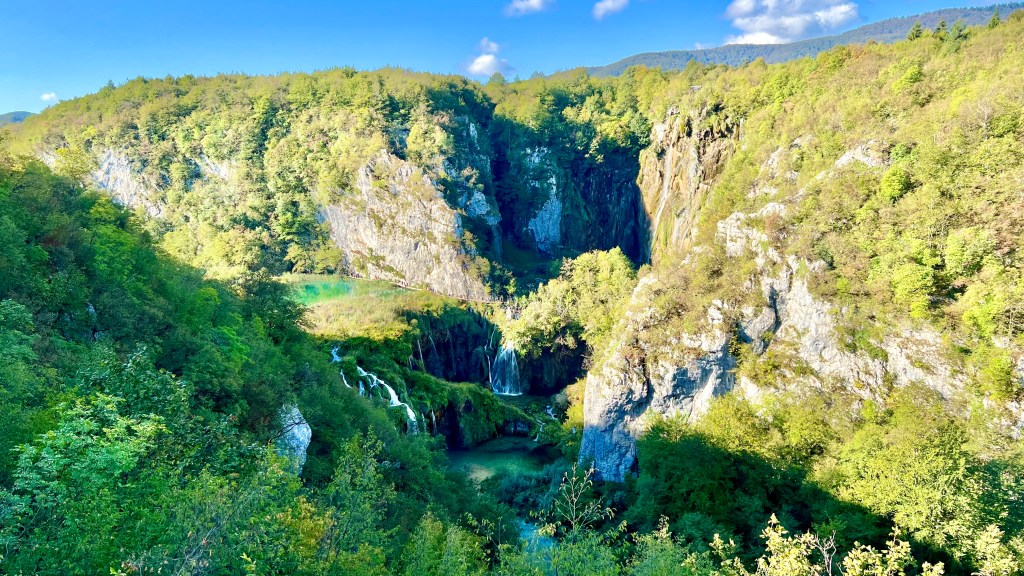











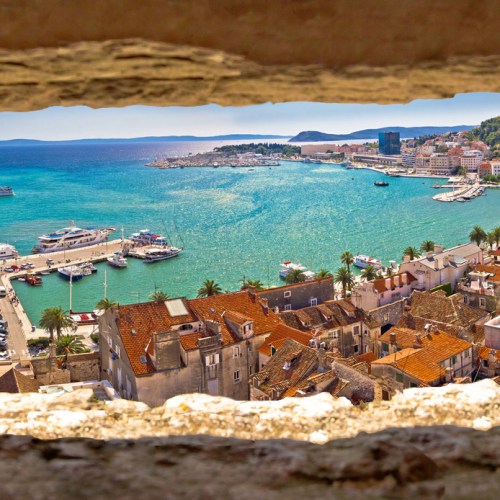
No comment yet, add your voice below!
Discover more from Travel The Four Corners
Subscribe now to keep reading and get access to the full archive.
Continue reading